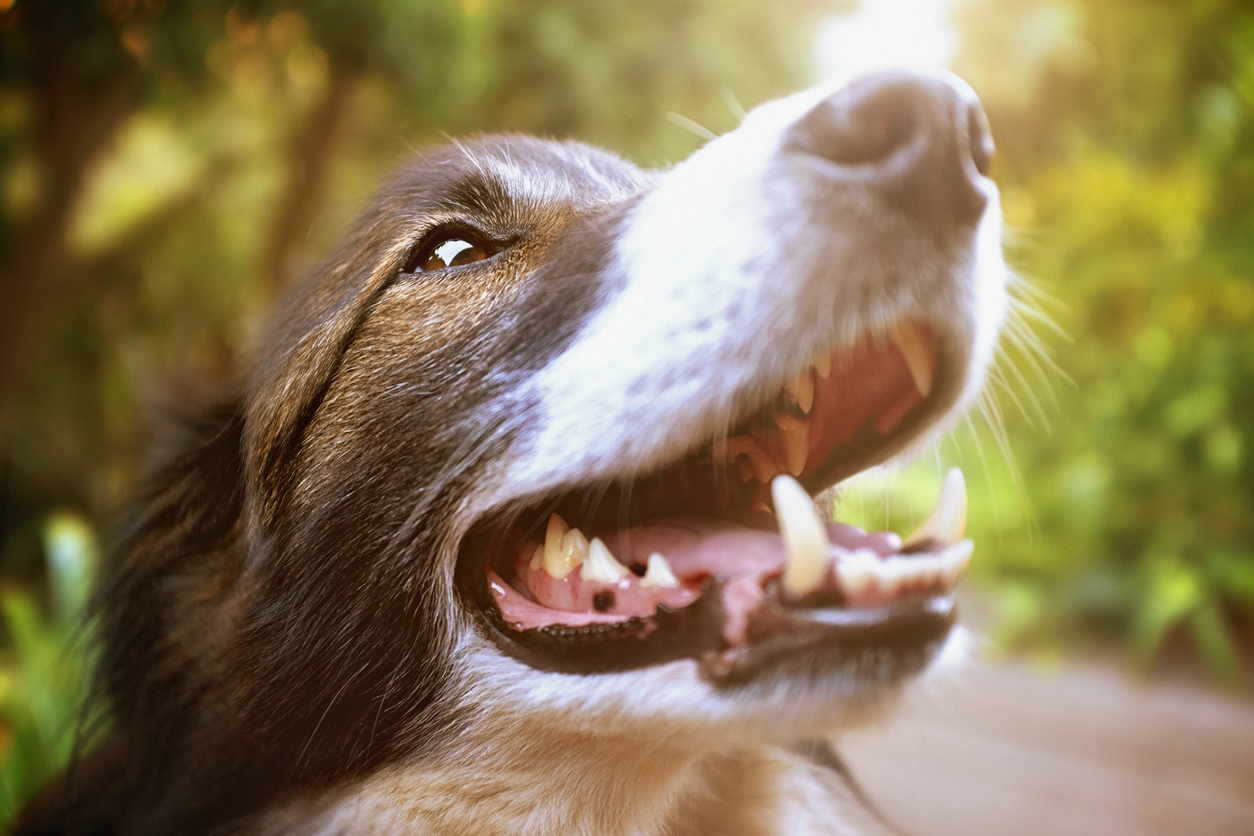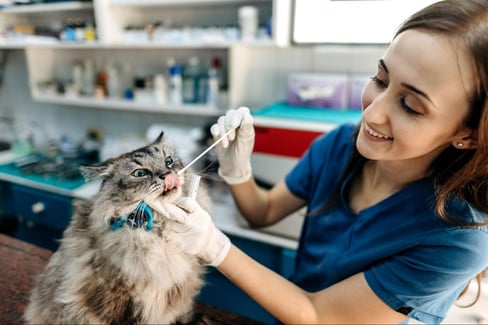Table of Contents
There’s a reason why people brush their teeth every day. Without daily brushing, bacteria that results in plaque and tartar build-up on our teeth, causing all sorts of issues from inflamed and bleeding gums to cavities and, over time, even rotting teeth. Gross! Plus, the feeling of gunk in your mouth isn’t exactly pleasant when we don't brush our teeth. Also, other people probably won’t enjoy smelling your bad breath.
It’s the same with your dog. Plaque and tartar can build up on their teeth, causing health issues that cause pain. One of the telltale signs that your dog needs dental attention is bad breath. Dog breath might be a common thing dog owners experience with their pup, but that doesn't mean it’s normal for your dog to have it.
If you have bad breath, the first thing you likely want to do is brush your teeth. A breath mint or gum will only go so far. So when your pup has bad breath, what should you do? That’s right, get out the doggy toothbrush!
It may seem odd at first, but getting your pup used to daily brushing can go a long way to keeping their teeth—and overall health—top-notch.
In this article, we explore dental care for dog, including why it’s important, tips for keeping your pup’s pearly whites in tip-top condition, and more.
Dog Dental Care and Why It’s Important
Imagine a super tiny bacteria that wants to find a host. To do so, it needs to hitch a ride. A piece of kibble in your dog’s bowl seems like a great fit for a first-class trip to a place where bacteria can thrive—your dog’s mouth. Pieces get stuck outside and between their teeth as your dog crunches and munches on their food. The perfect vacation destination for bacteria to hang out!
That’s not to mention that dogs (especially puppies) also use their mouth to help explore and learn more about the world around them. Dogs use their mouth during play, often engaging in light biting behaviours with humans and other dogs or animals.
As you can imagine, all this mouth stuff can lead to some pretty gnarly dental care dog problems. If left untreated, your poor pup could suffer from a lot of issues, as outlined in the table below:
|
Potential Problems From Poor Dental Care For Dogs |
Description and Risks |
|
General dental disease |
|
|
Tooth loss |
|
|
Bad breath |
|
|
Oral pain |
|
|
Organ damage |
|
To summarize, the key indicators of dental problems in dogs include:
- Bad breath
- Oral pain
- Reluctance to eat and/or drink
One important note about periodontal disease, which is such a common dental disease in dogs that it’s estimated that almost 90% of dogs will develop it at some level by only two years old, is that it can be difficult to spot until it’s in an advanced stage.
This is because periodontal disease in dogs lurks below the gums. Some dogs may appear to have beautiful white teeth on the surface, only to exhibit signs of oral pain. If this happens with your dog, seeking immediate dental care is important. In some cases, a veterinarian will have to x-ray a dog’s mouth in addition to a gum exam to discover periodontal disease. This is why regular tooth brushing and dental checkups for dogs are essential.
Dental Care Pet Benefits
The benefits of routine dental care for dogs include:
- A pain-free mouth
- Fresh breath
- A decrease in loose teeth and/or tooth loss
- Potential to prevent issues with heart, liver, and kidneys
- Early intervention to help prevent oral, jaw, and throat cancers
When Should My Dog Have His First Teeth Cleaning?
If you’ve just gotten a new puppy, you’re likely wondering when you should start with routine professional dog dental care. Of course, you’ll want to wait until your pup has a complete set of pearly whites to work with (which is usually when they are 3–5 months old), but other than that, how do you know when you should start cleaning your pet’s teeth?
Of course, the answer isn’t as simple as giving a particular age, as the optimal time to start cleaning your dog’s teeth depends on the dog’s breed. Smaller breed dogs can start getting their teeth cleaned as early as six months. This is because they have smaller heads and jaws, meaning their teeth are more crowded together than larger breed dogs—resulting in more bacteria and food particles getting trapped. Small brachycephalic breeds (dogs with flattened faces) like Pugs, Bulldogs, and Pekingese are more susceptible to plaque and tartar buildup because of confined headspace, but also because they are more likely to have bite abnormalities like an overbite or underbite, which can exacerbate dental problems.
- Owners of larger breed dogs can usually get away with taking their pup for teeth cleaning when they are older than six months.
- Some sources say taking your dog for a dental checkup at 2–3 years old is fine, but considering that signs of periodontal disease often show up in dogs under 3 years, it’s best to take your dog in for a dental cleaning and checkup earlier.
- Larger breed dogs could likely start their professional routine dental dog care at about a year old.
How Often Should Dog Dental Care Occur?
In terms of professional dental care for dogs, most veterinary professionals recommend that you take your dog for teeth cleanings at least once per year. Of course, smaller breed dogs and dogs with a genetic predisposition to poor dental health may require more frequent visits. You should develop a schedule that works for your dog with your veterinarian, ideally at your first pet dental care appointment.
One of the most important ways to keep your pup happy and healthy is to ensure that you practice preventative pet health measures. One of these measures is routine dental care. Because your pup’s mouth is a direct connection to the rest of their body, it’s important to keep it clean and well-maintained to prevent oral health issues and other health issues that could appear in the rest of their body and be affected by poor dental hygiene.
After all, your pup’s teeth are part of their skeleton, and maintaining your dog’s skeletal health, including their teeth, bones, and joints, positively affects their entire body. Aside from dental issues, as many as 20% of dogs that are one year old will experience joint issues. One of the ways that you can support your dog’s joint health as they age is by giving them a daily joint supplement.
TRI-ACTA is a great preventative joint supplement that you can start giving to your puppy as soon as they are ready to eat solid foods. This supplement contains:
- Two types of glucosamine for dogs, sulfate (provides sulfur to your dog’s joints, which is an essential component of joint health) and HCl (a highly bioavailable form of glucosamine that your dog’s body can take advantage of quickly)
- Chondroitin (essential for cartilage regeneration and repair)
- Methylsulfonylmethane (MSM, a natural anti-inflammatory)
TRI-ACTA is formulated with 100% active ingredients that are focused on your dog’s joint health.
Dental Care Dog Issues: What to Watch Out For
Because dental issues in dogs can be difficult to spot at times, it helps to know which oral-health-related ailments dogs commonly experience. These common conditions are outlined in the table below:
|
Common Dental Conditions in Dogs |
Signs & Symptoms |
|
Periodontitis (a serious gum infection that damages the soft tissue surrounding your dog’s teeth) |
|
|
Malocclusion (teeth are not aligned properly) |
|
|
Fractured, chipped, or broken teeth |
|
|
Oral infections |
|
|
Retained baby teeth |
|
When to Take a Dog to the Vet For Dental Care
If your dog is showing any signs that they are in discomfort or pain in and around their mouth, then immediate veterinary dental care is recommended. Waiting to give your dog dental care usually means that the issue will worsen, resulting in your dog being in more pain and your vet bill being higher when you finally do take your pup in for a dental check.
In addition, if your dog has dental issues, they may not be willing to eat or drink due to the pain. If your dog is still drinking, they can go for three to five days without food. However, if they are not drinking, that number gets much lower. Dogs that have not had water will show signs of dehydration in as little as 24 hours.
Dog Dental Care Tips
Giving your dog high-quality dental care is paramount to their overall health. Here are some dog dental care tips to help you save time and money on your dog’s dental care needs.
1. Dog Dental Care at Home: Getting Your Dog Used to Brushing
Getting your dog used to having fingers in and around their mouth is the first step to getting them used to having their teeth brushed. If you have a smaller dog, you can use a finger toothbrush (like the one recommended in our section below) as it will give you more control when brushing your dog’s teeth. You can use a regular human toothbrush for larger dogs if you wish. At first, it’s a good idea to gently rub your finger or the toothbrush in your dog’s mouth without vigorously brushing, just to get them used to the sensation of having a finger or toothbrush in their mouth. From there, you can slowly upgrade to actual brushing based on your dog’s comfort level.
Incorporating dog toothpaste is essential because, like human toothpaste, it helps remove built-up plaque in addition to brushing. The great thing about dog toothpaste as well is that, unlike human toothpaste, you don’t have to rinse out your dog’s mouth after brushing because it’s perfectly fine if they swallow it. Dog toothpaste products are available that are flavoured with their favourites, like beef, chicken, and peanut butter. Never use human toothpaste on your dog because it can contain xylitol, an artificial sweetener that can be toxic to dogs.
2. Brushing Frequency
Most professionals recommend that you try to brush your dog’s teeth at least three times a week. But if your dog tolerates or even grows to enjoy having their teeth brushed, brushing their teeth daily is optimal. Adding a doggy toothpaste in a flavour your pup loves might help your dog warm up to more frequent brushing.
3. Adding Dental Powder to Your Dog’s Meals
Just like adding a dog joint supplement powder to your dog’s meals helps them maintain strong joints, adding a dental powder to your dog’s meal can help them maintain healthy teeth. There are also dental chews and treats that you can incorporate into your dog’s diet as well, but keep in mind that these usually contain a fair number of additives and fillers, so be sure to check the ingredients carefully.
TRI-ACTA H.A. for Pets
Our maximum strength formula is optimally designed to accelerate the formation of cartilage, minimize inflammation, expedite the healing process, and improve joint conditions.

4. Small Dog Dental Care
Overall, small dog breeds have a much higher risk of dental disease compared to larger breeds. This is because smaller dogs have smaller heads, and their teeth are often more crowded in their mouths compared to larger dogs. This means the opportunity for plaque and tartar buildup is heightened due to more tiny nooks and crannies that bacteria can get into. What this means is that regular small dog dental care is even more important for our tiny pups.
5. Senior Dog Dental Care
As dogs age, their teeth will naturally wear down, and taking care of their dental health will become even more important. If the senior dog has had their teeth taken care of properly for their entire life with regular dental checkups and cleanings, then chances are their teeth will be in great condition. However, if the dog hasn’t had regular dog dental care, there may be some common senior dog dental care issues that you’ll need to address, such as broken or missing teeth, teeth that need extraction, and removal of years of plaque and tartar buildup.
Many senior dog owners are concerned about the effect that the anesthesia that’s needed for professional teeth cleanings will have on their dog.
Rest assured, as long as your dog is healthy overall, their risk for anesthesia isn’t heightened just because of their age. Your veterinarian will perform the necessary risk assessment to determine whether a cleaning procedure's positives outweigh any potential risks to your dog’s health.
Top Products for Dental Pet Care
Many dog dental care at-home products can help you keep your pup’s teeth and gums fresh and healthy. Here are our recommendations:
1. Best Bones / Dental Chews: Greenies Dental Chews
Greenies is probably one of the most recognizable dental chew brands for dogs in North America, and for good reason. These dental treats come in a wide variety of flavours, sizes, and shapes to appeal to all different types of dogs. The idea behind these treats is that they are hard, so your dog’s chewing and biting helps remove the built-up plaque and tartar on their teeth. It’s important to remember that these treats aren’t meant to replace regular teeth brushing or cleanings, and you should only give them to your dog on occasion, just like any other treat.
It’s also important to read the ingredients of Greenies carefully, as the treat does contain a fair number of different types of vitamins and minerals as well as some fillers and additives.
Starts at $12.99 CAD for a 340 g bag. Pricing as of November 2023.
2. Best Toothbrush & Toothpaste Kit: Bluestem Oral Care Chicken Flavor Toothpaste & Brush Kit For Dogs And Cats
This daily brushing kit from Bluestem stands out for a few reasons. First, the included toothbrush has medium-soft bristles, so they won’t be too hard for your pup’s teeth, nor will they be too soft to be able to perform any real cleaning. Second, the brush has two sizes to accommodate dogs with larger or smaller mouths. Third, the toothpaste itself is chicken-flavoured, which is a popular option that most dogs will love. Last but not least, the toothpaste’s ingredients are pretty standard, with not a lot of extra fillers or additives.
$18.57 CAD. Pricing as of November 2023.
3. Best Liquid Oral Care: Petco Well & Good Fresh Breath Water Additive
Keeping your dog’s mouth clean can be a chore, especially if they are resistant to brushing. One of the ways that you can help your pup’s teeth and gums stay cleaner is by using a dental water additive like Well&Good. This product is unscented and taste-free, so you can easily add it to your dog’s water bowl and they won’t even notice it as they lap it up. While it won’t replace daily brushing, you’ll notice a significant improvement in the smell of your dog’s breath!
$9.99 CAD for a 473 ml bottle. Pricing as of November 2023.
Summary
Maintaining your dog's dental health is just as crucial as caring for your own teeth. Neglecting their oral hygiene can lead to severe issues such as periodontal disease, tooth loss, organ damage, and even systemic infections.
Daily brushing, routine professional cleanings, and using dental care products designed for dogs can significantly improve their oral health and overall well-being. Understanding the signs of dental problems and starting dental care early in your dog’s life, irrespective of breed or size, is pivotal. Remember, your furry friend's teeth are vital for their comfort and health, so investing in dental care for dogs is a gift that keeps them smiling and thriving.
Aside from your dog’s teeth, your dog’s joints also need additional care and support. Incorporating a joint supplement like TRI-ACTA into your dog’s diet is essential to ensure that their joints stay healthy as they age.
Purchase TRI-ACTA online or learn where to buy at a store near you.
TRI-ACTA H.A. for Pets
Our maximum strength formula is optimally designed to accelerate the formation of cartilage, minimize inflammation, expedite the healing process, and improve joint conditions.

Newsletter Signup
Subscribe to our newsletter to receive the latest news and exclusive offers.
.jpg?height=2000&name=Cliick_Integricare-DISPLAY-REVISEDV2%20(1).jpg)
Proactive & Therapeutic Joint Supplements
When given daily, Integricare joint supplements recover bone and joint injuries faster and help prevent mobility injuries from happening in the first place.











